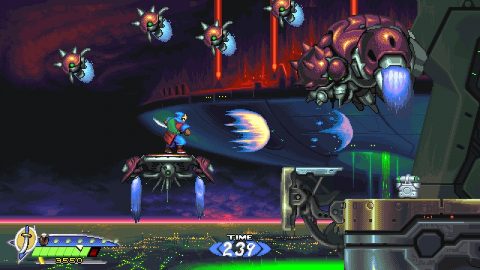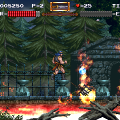- Shadow of the Ninja
- Shadow of the Ninja Reborn
Tengo Project is a small team consisting of developers who worked on Natsume’s 8/16-bit titles and have been remaking their older games for HD platforms, including Wild Guns, The Ninja Warriors, and Pocky & Rocky. Now they’ve reached back further in Natsume’s history to resurrect the NES game Shadow of the Ninja, the co-op side-scroller that pits ninjas Hayate and Kaede against the demonic forces of the Emperor Garuda. Their previous works were all based on SNES titles, with pixel artwork that increased the color depth and detail of the 16-bit games but still looking pretty similar. However, since Shadow of the Ninja was an NES game, they’ve had their work cut out for them to reimagine and update the visuals to put it on par with their other titles.
For the most part, it works. The original Shadow of the Ninja was very dark, but the updated visuals do a fantastic job of creating a futuristic, oppressive urban setting that makes fantastic use of color. The character illustrations are the lone weak point – despite being illustrated by members of Dynamic Pro, who worked on the art of the NES game, they’re much more cartoonish than how they were originally presented, with Hayate having an exaggerated expression and Kaede having a cartoonishly large chest. Yet these details aren’t really reflected in the character sprites, who blend in seamlessly with the world around them. Enemies see similar improvements, ranging from typical futuristic robots like robots and walking mechas, to more unusual types like large apes and elf-like mutant women. The soundtrack has also been given a high energy rocking arrangement by one of Natsume’s original composers, Iku Mizutani, all of which sounds nearly perfect.
The level designs have been expanded, using the NES levels as a baseline so they’re still recognizable but remodeling them to make them feel a little more expansive. The original game only had five levels, while this remake adds a new one, which takes place in a blast furnace and an enormous freezer. The bosses see the most impressive upgrades – take, for example, the second level boss, which was originally an enormous vehicle. Rather than just focusing on a single weak point, you have to take out a few extra sections, hopping on top of it while avoiding lasers to strike the final blows. The third level boss in the original game was some kind of samurai ghost that fell to pieces when getting hit but reassembled itself to continue attacking. In this remake, every few times you knock it down, it comes back larger, until eventually it’s an enormous monster consisting almost entirely of scrap metal and other junk. One late boss originally had you fight a falconer and his bird; here, once they’ve taken enough damage, they fuse together so the human grows a pair of robotic wings.
Along with the visual makeover and expanded levels, the ninjas movesets and weapons have also been radically expanded. Originally, the heroes were equipped with swords, along with side weapons that included a kusarigama chain, and limited use bombs and shurikens. In this remake, you’re always equipped with the sword and kusarigama, giving the option between the quick but short range sword attacks or long range, multi-directional chain attacks. You also now have an expanded inventory that includes several limited use weapons, including the old shurikens and bombs, along with newly added weapons like blades, claws, guns, caltrops, and a whole bunch of others. Included in this arsenal are power drinks that give your sword an energy blast until you take too many hits, as well as health items like rice balls and jugs of milk.
If you manage to complete a stage with any extra items remaining, these are unlocked in the ninja gear section. You also earn money during the levels, the highest amount of which is saved into a bank. Whenever you restart a new game, you can use that money to purchase any of these items to have equipped from the outset, allowing some level of customization. The downside is that this only applies to the first life; once you lose a life, all of your inventory is stripped to the default state, so in practice, it’s only useful if you intend to never die.
This will probably happen a lot, because Shadow of the Ninja is a pretty tough game. The original game was no walk in the park either, though not quite to the heights of something legendary like Ninja Gaiden. The original game expected you to make it through the whole game with only a few continues. This remake gives you only one life but unlimited continues, restarting you at the beginning of each section. It’s much more forgiving, so you can retry any stage pretty quickly, especially boss battles, but it also means that each individual section is more challenging than its corresponding level in the original game. Repeatedly fail a level, and the game will show some mercy by tossing an extra health item your way.
For the most part, it’s tough but fair. Some of the frustration comes with the territory. There’s plenty of spots where you can be knocked into pits by enemies, but at least you respawn nearby with only a small bit of damage. When dealing with subweapons and other items, you can only quickly switch between your sword and the most recently obtained item. If you need to dig further into your inventory, you need to hold down the equipment button and cycle through them. The game doesn’t pause when you’re doing this, so you need to play ahead, since you can’t really stop to rifle through your pockets when you’re being assaulted by robots.
But other annoying issues come down to some control quirks. The original NES game had some pretty snappy jumping, but this remake adds a split-second delay that makes the action feel a little less precise. The two characters control slightly differently, with Kaede having a shorter jump that makes some pits more challenging. Some of the hitboxes feel off, particularly the flamethrowers in the fourth stage, making it difficult to determine safe zones. Unseen enemies tend to attack from offscreen, particularly in vertically scrolling sections.
Other inconsistencies cause some headaches. When you’re holding onto an overhang, you need to press Up to leap up, as pressing the Jump button will cause you to fall. This is how it worked in the NES game too. But this game also lets you run up walls and hang onto ledges. Here, pressing Up does nothing, and instead you need to hit the Jump button to leap up. It’s one of those things you can eventually learn but it’s often frustrating to deal with in the heat of the action. Also, your sword can destroy most projectiles, except for homing missiles, for some reason. And, perhaps most importantly, if you want to save your progress, make sure to die and quit on the Game Over screen. If you pause and quit, it won’t record your level at all. The game doesn’t make this clear at all, to the point that it feels like a bug.
Some of these issues are aggravating, and while some provide intentional friction, others just seem like they weren’t thought through. But maybe that’s okay. 8-bit action games were tough not only because programming them was difficult, but also because they were charting new design ground, without any list of best practices. Nowadays, many new-retro platformers are made with easy-to-use development tools and come with decades of design experience, resulting in games that are perhaps overly polished. Maybe Shadow of the Ninja isn’t really Shadow of the Ninja without some kind of roughness that encapsulates an old school challenge, giving it a truly authentic feel to a lovingly gorgeous remake.
Screenshot Comparisons


